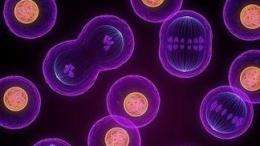A protein that regulates fat cell production and cell division

Swiss scientists have teased out the role that a protein known as SMRT plays in regulating the production of fat cells. And in the process, they made another, unexpected discovery; this protein also plays a critical role in the division of cells that ultimately store fat.
How does the body produce fat cells? EPFL scientists have uncovered the role of SMRT, a protein involved in regulating this phenomenon. And in the process of investigating this, they discovered another critical role played by SMRT in a variety of cell division and differentiation processes. This double discovery was published online April 19, 2012, in the journal Molecular Cell.
The production of fat cells, known as adipocytes, is the outcome of a long and complicated molecular process. Given the right conditions, certain stem cells can differentiate into bone, cartilage, or fat cells. It has been known for quite some time that a protein known as SMRT is a critical part of this transformation. But the exact, molecular role it plays has remained a mystery.
SMRT is a so-called “co-repressor” protein; it doesn’t act alone, but by binding with another protein that in turn has the ability to bind with a strand of DNA. As long as SMRT stays bound to its host, the stem cell won’t transform into a fat cell. EPFL professor Bart Deplancke and his team were able to pry apart the details of this process and reconstruct the origins of adipogenesis.
The birth of a fat cell; a play in three acts
Act I. SMRT is bound to its host, another protein, C/EBPβ, which is in turn bound to a strand of DNA. SMRT acts as a plug or kind of umbrella, preventing other proteins from binding with the host or anywhere in the vicinity. The stem cell is still undifferentiated at this stage.
Act II. Certain substances secreted by our bodies, such as insulin, activate the protein. SMRT detaches from its host, making way for other proteins to come onto the stage and attach themselves in the area.
Act III. Once these proteins are assembled, they activate the genes responsible for differentiating the stem cell into a fat cell. SMRT thus plays a critical role: it prevents premature differentiation. “It’s through this protein that insulin, among other components, is involved in the regulation of fat cell production,” explains Deplancke. “If we remove SMRT from our cells in culture, they transform more rapidly into fat cells, without waiting for the right signal.”
At the moment, the scientists don’t know to what extent a malfunction in this process could be responsible for cases of congenital obesity. But according to Deplancke, the hypothesis is highly plausible and deserves further investigation.
SMRT’s other unexpected starring roles – a second discovery
The scientists also made an unexpected discovery while conducting the research outlined above. While tracking its presence in cells, they found that the protein was often in the vicinity of a specific DNA sequence, one that had been of interest to the scientific community for quite some time.
“We know two things about this DNA sequence,” explains Deplancke. “First, it appears more frequently than statistics would predict, and in all the mammals whose genomes are well understood. Second, it is systematically located inside promoters of genes implicated in cell division, in other words, the basic function of any multicellular organism.” Biologists thus have good reason to suspect that it plays a critical role in this cell function.
Deplancke’s team discovered that SMRT could bind with a protein called KAISO, which in turn binds to this mysterious DNA sequence, but only in very specific conditions. “The sequence must be methylated (NLDR: methylation is a chemical transformation that modifies the properties of DNA) in order for KAISO to bind with it. This explains why biologists, who have been searching for the proteins that bind to this sequence for years, have never been able to find anything.”
By removing SMRT from KAISO, the scientists observed something very interesting: the cell divided much more rapidly than it should have. Without technically meeting the definition of a malignant cell, it did nonetheless exhibit certain fundamental behaviors of one.
Whether for the production of fat cells by binding with C/EBPβ, or for regulating cell division by binding with KAISO, SMRT is clearly a protein that plays a critical regulatory role in the cell. “We know that for most cells to be able to differentiate, it needs a certain number of division cycles,” explains Deplancke. “This leads us to believe that SMRT plays a critical guardian role, by regulating the processes of division and differentiation of the cell, and that its function is much more far-reaching than just the production of fat cells.”
More information: Sunil K. Raghav, et al., Integrative Genomics Identifies the Corepressor SMRT as a Gatekeeper of Adipogenesis through the Transcription Factors C/EBPb and KAISO, Molecular Cell (2012), doi:10.1016/j.molcel.2012.03.017
Journal information: Molecular Cell
Provided by Ecole Polytechnique Federale de Lausanne
















